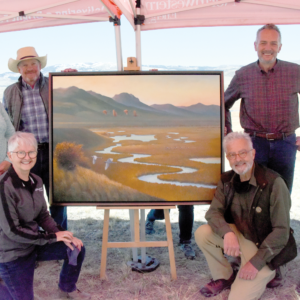From Northern Ag Network
The Producer Partnership has announced plans to open the first non-profit, federally inspected livestock processing facility in Montana. It will be located 12 miles east of Livingston and able to process up to 300 animals per month when operating at full capacity. The Producer Partnership was organized in April 2020 with the mission of farmers and ranchers working to end hunger in Montana.
To date, the Partnership has donated more than 80,000 pounds of hamburger to the Montana Food Bank Network (MFBN) to support individuals and families facing food insecurity across the state.
“We could have done twice that number if we could have booked more slots with one of the five federal processing facilities in the state. From day one, it has been an uphill battle processing donated cull animals,” Producer Partnership Founder and President Matt Pierson said. “You know, every step of the way that we’ve taken, this whole project has been a milestone and the first of its kind. This is just the next step in the evolution of being able to control our own destiny.”
In March, Friesla (a Washington-state-based company) was contracted to build the modular processing facility. These units operate at half the cost of the traditional brick and mortar facilities and are significantly less expensive to build.
“We’re honored to support Producer Partnership’s mission of working to end hunger in Montana,” Friesla Founder and President Bob Lodder said.
The total investment when the Partnership’s doors open is projected to be around $2.5 million.
“Last year, we turned away more live animals than I’d like to admit because we couldn’t find and kill and process date, so we were forced to go out of state and work with Yellowstone River Beef in North Dakota,” Pierson said. “I knew we needed something of our own to reduce processing fees, insure we could process animals on demand, and if we truly want to end hunger in Montana, at least with hamburger, we needed our own processing plant.”
Lodder added to Pierson’s statement, and explained the basics of the unit to be constructed for the Producer Partnership.
“Their modular Meat Processing System — proudly designed and built in the USA by our Friesla family — will allow them to take full control of their meat processing operations: from donation to harvest to distribution,” Lodder said.
Lodder said processing onsite will help the Partnership ensure meat quality and traceability, minimize transportation costs, and use less power and water than a traditional brick and mortar facility — ultimately saving time and money that can instead be invested in helping feed people in need.
The first service goal of the partnership will be to process at least 7 animals per week or a total of 140,000 pounds of hamburger for the MFNB. Concurrently, to help offset costs and pay for the facilities’ operation, retail processing services will be made available to producers who are part of the Producer Partnership family.
Producers wanting to tap into the direct pasture to plate market are centralized to process, package, and distribute their products will be enrolled as partners. While the program partnership is evolving daily, Pierson’s vision is to provide a fair priced retail processing facility to donors of cull animals and hamburger while serving the local farm to table meat business. Not only will the unit benefit the Producer Partnership for their own processing of donated animals for hamburger, but other producers eager to sell their own products as well.
“We hope to provide the MFBN with all its hamburger annually, support local producers with local processing of animals, and pay for the operation through donations and retail sales. It truly is a meaningful and beneficial partnership at all levels,” Pierson added. “There’s multiple benefits to the entire Producer Partnership mission. It started by soliciting cull animals for local producers, lining up processing of the animals and paying for the service, then facilitating the donation of hamburger by the producer to the MFBN and other qualified community centers. A producer that donates animals may receive a tax donation benefit for the value of the hamburger.”
Other benefits of the Producer Partnership’s processing unit are employment and volunteer opportunities.
“We’ll need meat cutters, people to package the meat, a supervisor to run the plant…the whole nine yards,” Pierson said. “We’re looking for the right kind of people who want to learn while helping the community.”
Although the construction of a processing unit is a large step for the organization, Pierson said he’s already looking on to the Producer Partnership’s next steps. During their Quiet Phase of a fund-raising campaign, the partnership has already raised $1,250,000 toward their goal.
Pierson went on to discuss other goals, hopes, and plans for the Producer Partnership.
“The goal, to start, is to be able to make it so that the MFBN will never have to buy any hamburger. After that, we want to go after every school in the state and continue to grow,” Pierson said with anticipation in his eyes.
With the opening of the Producer Partnership’s processing facility so quickly after the organization’s birth, it’s easy to say the sky is the limit.
“I’m excited…that’s the only way to describe it,” Pierson concluded. “I mean, we sent over the deposit for our own processing unit within a year of dropping off our first donation of beef. This organization has grown from just a simple spreadsheet on my computer to 501(c) status, and soon enough, our own processing facility – it’s crazy, overwhelming, and flat-out incredible. I cannot wait to see what’s in store for the Producer Partnership and how we will continue to end hunger in Montana.”

